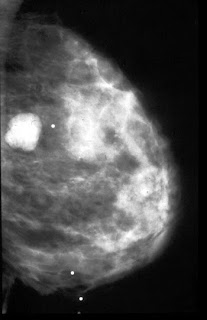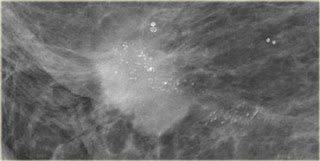- BI-RADS 2 =Benign Finding:Like BI-RADS 1, this is a normal assessment, but here, the interpreter chooses to describe a benign finding in the mammography report.
1- Involuting calcified fibro adenomas.
2- Multiple secretory calcifications.
3- Vascular calcifications.
4-fat-containing lesions such as oil cysts, lipoma, galactoceles and mixed-density Hamartoma all have characteristically benign appearances, and may be labeled with confidence.
5- Intramammary lymph nodes.
6- Implants.
7- Architectural distortion clearly related to prior surgery.
Types of Calcification seen with this category:
-Diffuse calcification.
-Round calcification:
*Size > 0.5mm
*Shape = Coarse & round with well-defined edges.
-Bilateral & diffuse amorphous calcification.
*size <>
*shape = round or flakes with hazy margins.
-Vascular calcification.
-Multiple secretory calcification.
Radiologist is still concluding that there is no mammographic evidence of malignancy.
1- Involuting calcified fibro adenomas.
2- Multiple secretory calcifications.
3- Vascular calcifications.
4-fat-containing lesions such as oil cysts, lipoma, galactoceles and mixed-density Hamartoma all have characteristically benign appearances, and may be labeled with confidence.
5- Intramammary lymph nodes.
6- Implants.
7- Architectural distortion clearly related to prior surgery.
Types of Calcification seen with this category:
-Diffuse calcification.
-Round calcification:
*Size > 0.5mm
*Shape = Coarse & round with well-defined edges.
-Bilateral & diffuse amorphous calcification.
*size <>
*shape = round or flakes with hazy margins.
-Vascular calcification.
-Multiple secretory calcification.
Radiologist is still concluding that there is no mammographic evidence of malignancy.
Category 2=secretory calcification Category 2 =fibroadenoma
Category 2 =fibroadenoma Category 2 =vascular calcification
Category 2 =vascular calcification 
 FAT CONTAINING LESIONS
FAT CONTAINING LESIONS
 Category 2 =fibroadenoma
Category 2 =fibroadenoma Category 2 =vascular calcification
Category 2 =vascular calcification 
 FAT CONTAINING LESIONS
FAT CONTAINING LESIONSCategory 2 = oil cyst
 Category 2 = lipoma
Category 2 = lipoma 
 Category 2 = galactocele with fat/fluid level in a lactating women
Category 2 = galactocele with fat/fluid level in a lactating women  Category 2 = mixed density hamartoma
Category 2 = mixed density hamartoma
 Category 2= intramammary lymph node with fatty hilum
Category 2= intramammary lymph node with fatty hilum
 Category 2 =round calcification
Category 2 =round calcification  -BI-RADS 3 = Probably Benign Finding - Initial Short-Interval Follow-Up Suggested:A finding placed in this category should have less than a 2% risk of malignancy.It is not expected to change over the follow-up interval, but the radiologist would prefer to establish its stability.Lesions appropriately placed in this category include:·
-BI-RADS 3 = Probably Benign Finding - Initial Short-Interval Follow-Up Suggested:A finding placed in this category should have less than a 2% risk of malignancy.It is not expected to change over the follow-up interval, but the radiologist would prefer to establish its stability.Lesions appropriately placed in this category include:·
1-Non palpable, circumscribed mass on a baseline mammogram (unless it can be shown to be a cyst, an intramammary lymph node, or another benign finding),·
2-Focal asymmetry which becomes less dense on spot compression view·
3- Bilateral and Clusters of amorphous calcifications·

 Category 2 = lipoma
Category 2 = lipoma 
 Category 2 = galactocele with fat/fluid level in a lactating women
Category 2 = galactocele with fat/fluid level in a lactating women  Category 2 = mixed density hamartoma
Category 2 = mixed density hamartoma Category 2= intramammary lymph node with fatty hilum
Category 2= intramammary lymph node with fatty hilum Category 2 =round calcification
Category 2 =round calcification  -BI-RADS 3 = Probably Benign Finding - Initial Short-Interval Follow-Up Suggested:A finding placed in this category should have less than a 2% risk of malignancy.It is not expected to change over the follow-up interval, but the radiologist would prefer to establish its stability.Lesions appropriately placed in this category include:·
-BI-RADS 3 = Probably Benign Finding - Initial Short-Interval Follow-Up Suggested:A finding placed in this category should have less than a 2% risk of malignancy.It is not expected to change over the follow-up interval, but the radiologist would prefer to establish its stability.Lesions appropriately placed in this category include:·1-Non palpable, circumscribed mass on a baseline mammogram (unless it can be shown to be a cyst, an intramammary lymph node, or another benign finding),·
2-Focal asymmetry which becomes less dense on spot compression view·
3- Bilateral and Clusters of amorphous calcifications·
BI-RADS 4 = Suspicious Abnormality - Biopsy Should Be Considered:BI-RADS 4 is reserved for findings that do not have the classic appearance of malignancy but have a wide range of probability of malignancy (2 - 95%). By subdividing Category 4 into 4A, 4B and 4C , it is encouraged that relevant probabilities for malignancy be indicated within this category so the patient and her physician can make an informed decision on the ultimate course of action.
Calcification associated with this category:
-Coarse and heterogenous calcification.
-Amorphous calcification with unilateral cluster distribution.
-Pleomorphic calcification with segmental calcification.
Calcification associated with this category:
-Coarse and heterogenous calcification.
-Amorphous calcification with unilateral cluster distribution.
-Pleomorphic calcification with segmental calcification.
.jpg) Pleomorphic calcification with segmental distribution
Pleomorphic calcification with segmental distribution  Amorphous calcification with unilateral clusters
Amorphous calcification with unilateral clusters 
coarse heterogenous calcification
BI-RADS 5 = Highly Suggestive of Malignancy. Appropriate Action Should Be Taken: BI-RADS 5 must be reserved for findings that are classic breast cancers, with a >95% likelihood of malignancy.
1-A speculated, irregular high-density mass
2-a segmental or linear arrangement of fine linear calcifications
3- An irregular speculated mass with associated pleomorphic , linear or curvilinear calcifications.
BI-RADS 5 contain lesions for which one-stage surgical treatment could be considered without preliminary biopsy. However, current oncologic management may require percutaneous tissue sampling as, for example, when sentinel node imaging is included in surgical treatment or when neoadjuvant chemotherapy is administered.
BI-RADS 5 = Highly Suggestive of Malignancy. Appropriate Action Should Be Taken: BI-RADS 5 must be reserved for findings that are classic breast cancers, with a >95% likelihood of malignancy.
1-A speculated, irregular high-density mass
2-a segmental or linear arrangement of fine linear calcifications
3- An irregular speculated mass with associated pleomorphic , linear or curvilinear calcifications.
BI-RADS 5 contain lesions for which one-stage surgical treatment could be considered without preliminary biopsy. However, current oncologic management may require percutaneous tissue sampling as, for example, when sentinel node imaging is included in surgical treatment or when neoadjuvant chemotherapy is administered.

speculated irregular high density mass

Fine linear calcification
.jpg)
Pleomorphic calcification in a linear pattern





No comments:
Post a Comment